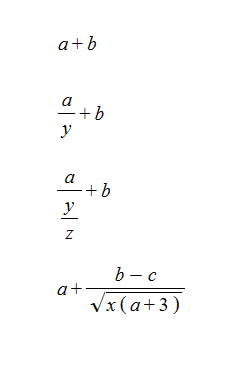The Rendering Editor
Renderings control how each object is displayed in a document. Renderings are created and edited using the Rendering Editor and are attached to object definitions in Object Modules. An object definition can contain zero, one or more renderings. If no rendering is assigned to an object definition, a default rendering is used to display the object.
A rendering determines the relationship each element has to other elements in an object when a visual display of an expression is generated.
Renderings contain a combination of the parameters of an object along with symbols and lines. The relative positioning and the scaling of the components in the display is defined by the rendering.
All of the following examples are based on the Add object a + b, which contains two parameters (a and b) and one symbol (the ‘+’ sign). Note how the original parameters a and b in the rendering are replaced by other expressions when the Add object is used in a document.

The rendering for the object a + b determines how the parameters are positioned relative to the ‘+’ sign. This positioning can change when a is replaced by a taller element such as a/y or a/(y/z).
Parameters are object elements that can be replaced with another expression, while symbols and lines remain unchanged. A Symbol can be any character you choose, such as a + sign or the π symbol. Lines are drawn individually and can be used in combination with other elements or as a standalone rendering.
The type definition in an object definition determines the number of parameters allowed in the object. The Rendering Editor automatically adds the correct number of parameters when a rendering is created. An object can have an unlimited number of symbols and lines, but the number of parameters is determined by the type definition.
